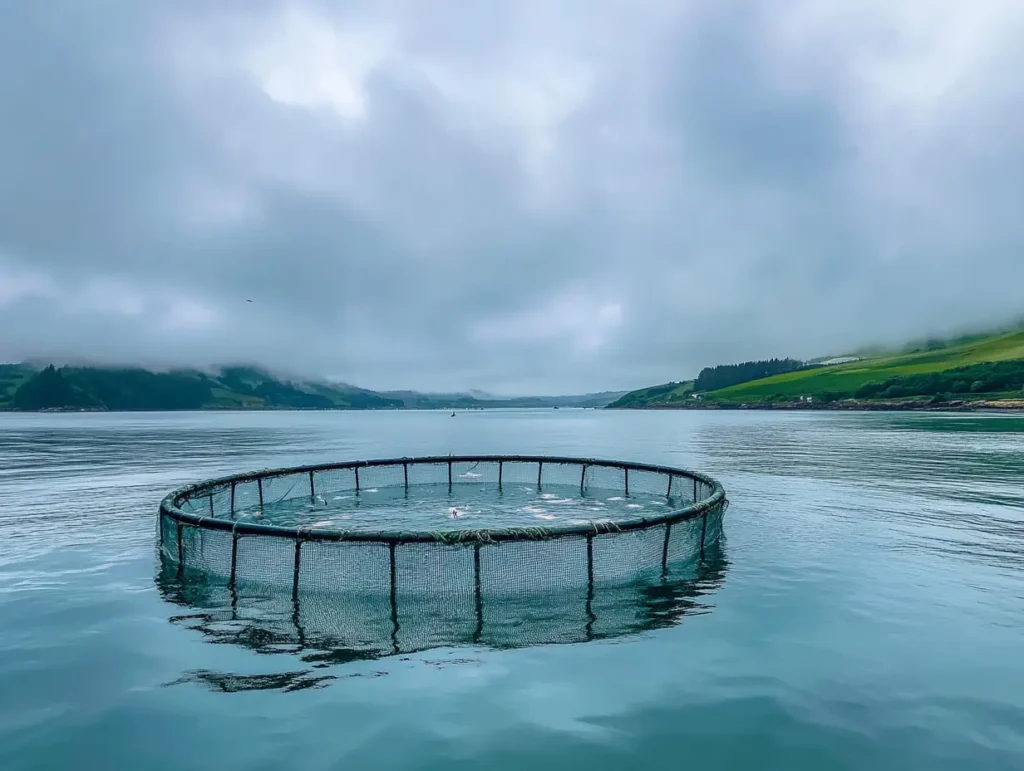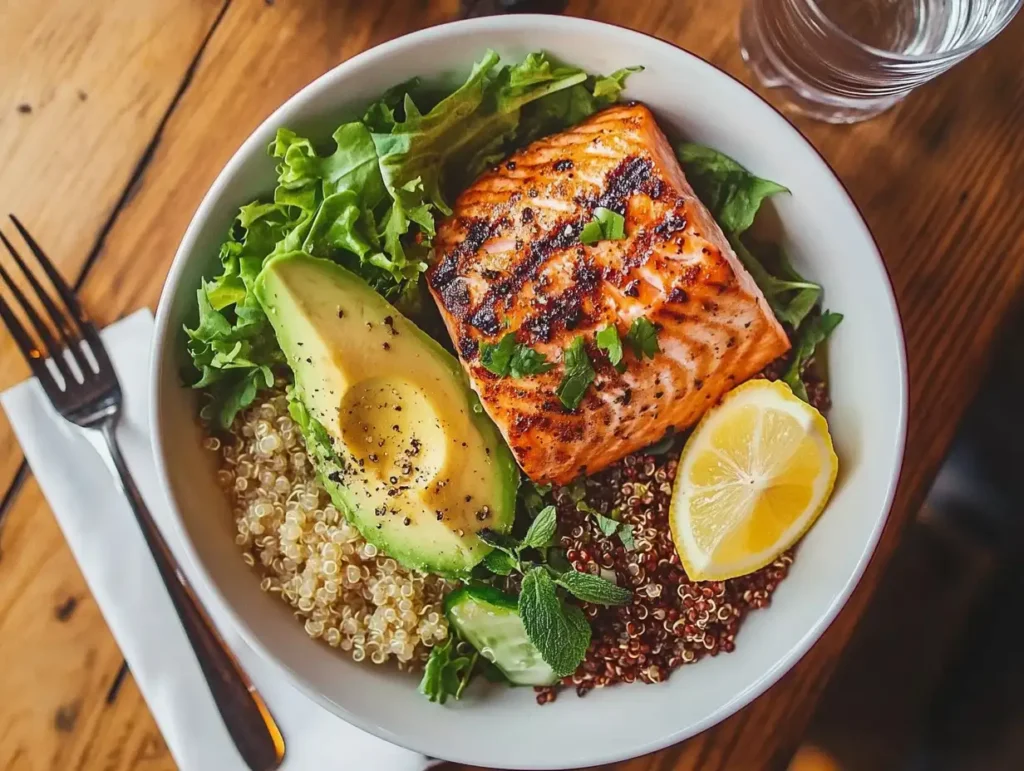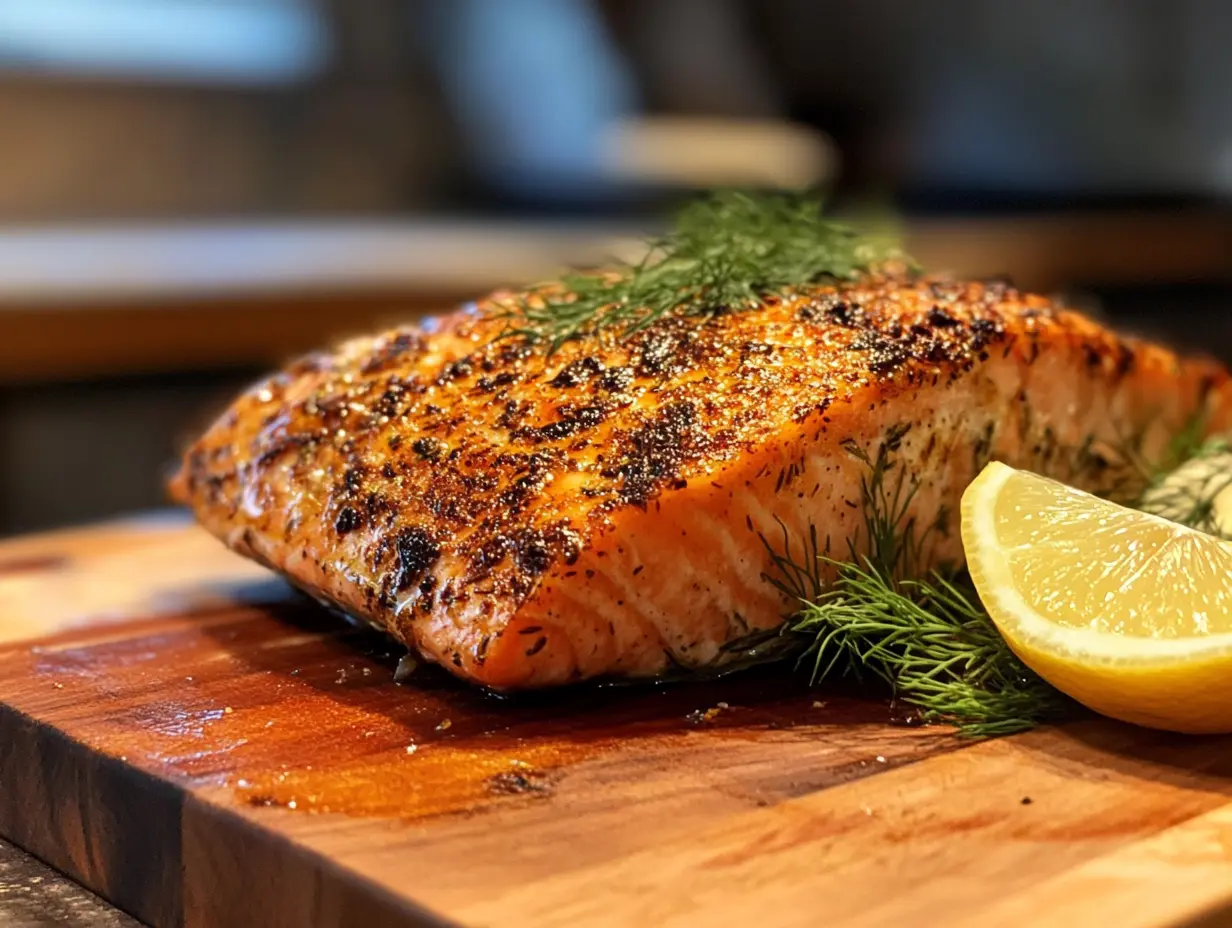Why is it not good to eat a lot of salmon? Salmon has earned its reputation as a superfood, but even the healthiest foods can pose risks if consumed excessively. Below, we delve deeper into why eating too much salmon might not be the best choice for your health, the environment, and your overall dietary balance.
Table of contents
Why eating too much salmon is bad
Why Is It Not Good to Eat a Lot of Salmon Due to Mercury?
Mercury is a naturally occurring element that can become concentrated in fish through environmental pollution. While salmon is considered a low-mercury fish compared to larger predators like tuna or swordfish, it’s not entirely free from this contaminant. Eating large amounts of salmon increases the cumulative exposure to mercury in your body. Over time, this can result in:
- Neurological damage: Mercury is neurotoxic, and high levels can impair cognitive function, memory, and coordination.
- Harm to unborn babies: Pregnant women are particularly advised to limit salmon intake, as mercury can interfere with fetal brain development.
- Behavioral issues in children: Even small increases in mercury levels can affect learning and behavior in young children.
The FDA and EPA recommend limiting weekly consumption of low-mercury fish, including salmon, to approximately 12 ounces for adults and even less for children.
Why Is It Not Good to Eat a Lot of Farmed Salmon?

Farmed salmon, which makes up a significant portion of salmon consumed globally, often contains higher levels of polychlorinated biphenyls (PCBs) and other industrial pollutants compared to wild-caught varieties. These harmful chemicals, introduced through contaminated feed or water, accumulate in the fatty tissue of the fish.
Consuming high levels of PCBs has been associated with:
- Cancer risks: Studies link long-term PCB exposure to an increased risk of liver and bile duct cancers.
- Immune system suppression: PCBs can weaken the immune system, leaving you more susceptible to infections and illnesses.
- Endocrine disruption: These chemicals can mimic or block hormones, potentially leading to reproductive and developmental issues.
Why Is It Not Good to Eat a Lot of Salmon for Omega-3s?
While omega-3 fatty acids are beneficial for heart health, inflammation reduction, and brain function, consuming too much can cause adverse effects. Overloading on omega-3s through frequent salmon meals may lead to:
- Blood-thinning effects: Omega-3s can reduce the blood’s ability to clot, increasing the risk of bruising or excessive bleeding.
- Imbalance with omega-6 fatty acids: An overabundance of omega-3s can disrupt the body’s balance between omega-3 and omega-6 fatty acids, potentially interfering with certain cellular functions.
Why Is It Not Good to Eat a Lot of Salmon for a Balanced Diet?
Relying too heavily on salmon as your primary protein source can crowd out other important food groups. A well-rounded diet is essential for optimal health. Overconsumption of salmon may lead to:
- Nutritional gaps: Salmon lacks dietary fiber, essential for gut health, which is abundant in fruits, vegetables, and whole grains.
- Overconsumption of calories and fat: Farmed salmon, in particular, contains more fat than its wild counterpart, contributing to higher calorie intake and potentially weight gain if not balanced.
Why Is It Not Good to Eat a Lot of Salmon for the Environment?
The environmental footprint of farmed salmon is another reason to moderate your consumption. High demand for salmon has led to the proliferation of aquaculture, but these farming practices often come at a cost:
- Habitat destruction: Salmon farms can pollute local waterways with excess feed, waste, and chemicals, disrupting ecosystems.
- Overfishing for feed: Farmed salmon are often fed fish meal made from smaller, wild-caught fish. Overfishing these species depletes marine biodiversity.
- Risk of disease spread: Parasites and diseases from salmon farms can spread to wild populations, endangering their survival.
Choosing wild-caught salmon or sustainably farmed options can mitigate some of these environmental concerns.
Why Is It Not Good to Eat a Lot of Salmon With High Fat Toxins?
Salmon’s high fat content, particularly in farmed varieties, makes it a repository for fat-soluble toxins such as dioxins and chlorinated pesticides. These compounds:
- Persist in the body for long periods.
- Can affect liver function and hormone regulation.
- Pose carcinogenic risks when consumed in large amounts over time.
Cooking Methods and Added Risks
How you prepare salmon can also influence its health impact. Cooking salmon at high temperatures, such as grilling or frying, can create harmful compounds like heterocyclic amines (HCAs) and polycyclic aromatic hydrocarbons (PAHs). Regular consumption of salmon cooked in this way might:
- Increase cancer risk due to the formation of these carcinogens.
- Neutralize some of the fish’s beneficial properties, such as its antioxidant content.
For safer preparation, opt for baking, steaming, or poaching salmon.
Cost of Overconsumption
Eating salmon frequently may not only affect your health but also your wallet. Wild-caught salmon, the healthier choice, is often significantly more expensive than farmed varieties. Over time, this could lead to unnecessary strain on your grocery budget, especially if consumed in large quantities.
Mental and Emotional Aspects
Interestingly, overindulgence in any single food, including salmon, can lead to food fatigue. The repetitive consumption of salmon may reduce your enjoyment of meals and lead to dissatisfaction with your diet overall. Balancing salmon with other foods keeps your meals exciting and varied.
Balancing these concerns with salmon’s undeniable benefits underscores the importance of moderation. Enjoying salmon as part of a diversified diet not only maximizes its health benefits but also minimizes potential risks.
Farmed vs. Wild Salmon: What’s the Difference?
The distinction between farmed and wild salmon is crucial when evaluating the health impacts, environmental implications, and overall quality of this popular fish. While both types of salmon are nutritious, their differences can significantly influence their safety, sustainability, and place in your diet.
Wild Salmon: A Natural Choice
Wild salmon are caught in their natural habitats, such as rivers and oceans, where they feed on a diverse diet of smaller fish, krill, and plankton. This natural environment directly impacts their nutritional composition, taste, and overall quality.
Advantages of Wild Salmon:
- Lower Contaminant Levels: Wild salmon generally contains fewer polychlorinated biphenyls (PCBs), dioxins, and other toxins due to its natural diet.
- Lean Protein Source: Wild salmon has less fat and calories compared to farmed salmon, making it ideal for those monitoring their caloric intake.
- Nutrient Density: Higher levels of certain nutrients, such as omega-3 fatty acids and selenium, are commonly found in wild salmon.
- Environmental Benefits: Wild salmon is caught sustainably in many fisheries, which helps preserve ecosystems when done responsibly.
Disadvantages of Wild Salmon:
- Cost: Wild salmon is often significantly more expensive than its farmed counterpart due to limited availability and the labor-intensive fishing process.
- Seasonal Availability: Wild salmon is only available at certain times of the year, making it less accessible year-round.
Farmed Salmon: Widely Available but Riskier
Farmed salmon is raised in aquaculture environments, such as net pens or tanks, where it is fed a controlled diet of fishmeal, plant-based ingredients, and synthetic supplements. These conditions create stark differences compared to wild salmon.
Advantages of Farmed Salmon:
- Affordability: Farmed salmon is generally cheaper than wild salmon due to controlled breeding and production.
- Consistent Supply: Available year-round, farmed salmon ensures a steady and reliable source of this popular fish.
- Higher Fat Content: While this is often considered a drawback, the higher fat content of farmed salmon may appeal to those seeking a richer, oilier texture.
Disadvantages of Farmed Salmon:
- Higher Contaminant Levels: Farmed salmon often contains higher levels of PCBs, dioxins, and other pollutants due to the feed and crowded conditions in fish farms. These contaminants can accumulate in human tissue over time, posing health risks.
- Increased Fat and Calories: Farmed salmon typically has more fat—up to 50% more than wild salmon—which can contribute to higher calorie consumption. Additionally, a higher fat content means it may store more toxins.
- Artificial Coloring: Farmed salmon’s pink hue is often enhanced using synthetic carotenoid additives like astaxanthin, as the natural color from a wild diet is absent. While deemed safe, some people prefer to avoid such additives.
- Environmental Impact: Fish farming contributes to pollution, habitat destruction, and the spread of diseases and parasites to wild populations. Overcrowded pens can produce large amounts of waste, threatening local marine ecosystems.
Nutritional Comparison
While both wild and farmed salmon are nutritious, their differences in fat composition, contaminants, and nutrient density are worth noting:
| Nutrient | Wild Salmon (per 100g) | Farmed Salmon (per 100g) |
|---|---|---|
| Calories | 160 kcal | 208 kcal |
| Total Fat | 6 g | 13 g |
| Omega-3 Fatty Acids | 1.5 g | 2.3 g |
| Protein | 25 g | 22 g |
| PCBs (contaminants) | Lower levels | Higher levels |
Wild salmon is leaner and contains fewer toxins, while farmed salmon is higher in fat and contaminants but often more accessible and affordable.
Taste and Texture Differences
The flavor and texture of salmon can also vary between wild and farmed varieties due to differences in diet and fat content.
- Wild Salmon: Firm, less oily, and features a more nuanced, briny flavor that reflects its natural diet.
- Farmed Salmon: Richer, softer, and more buttery due to its higher fat content. The flavor is milder and less distinctive than wild salmon.
Environmental and Ethical Concerns
The environmental impact of salmon farming is a growing concern, particularly as demand for the fish increases.
Wild Salmon Concerns:
- Overfishing: Poorly managed fisheries can lead to population declines and disrupt ecosystems. However, many regions enforce strict regulations to ensure sustainability.
Farmed Salmon Concerns:
- Habitat Pollution: Salmon farms release excess feed, waste, and chemicals into surrounding waters, damaging local ecosystems.
- Feed Resource Strain: Farmed salmon require large amounts of feed, including fishmeal made from smaller species, contributing to overfishing in some areas.
- Disease and Parasites: Crowded conditions in salmon farms promote the spread of sea lice and infectious diseases, which can impact wild populations when farmed fish escape.
Tips for Eating Salmon Safely
Salmon can be a healthy and delicious addition to your diet, but following certain guidelines ensures you reap the benefits while minimizing potential risks. Whether you’re selecting, preparing, or consuming salmon, these tips will help you make informed choices for optimal safety and health.
Limit Consumption to Safe Levels
The U.S. Food and Drug Administration (FDA) and Environmental Protection Agency (EPA) recommend eating 2–3 servings of low-mercury fish like salmon per week. This equates to approximately 8–12 ounces for adults.
- Children: Limit to smaller portions, as their developing systems are more sensitive to contaminants.
- Pregnant and Breastfeeding Women: Stick to 2 servings (about 8 ounces) of salmon weekly to minimize mercury and toxin exposure while benefiting from omega-3 fatty acids essential for fetal brain development.
Choose the Right Type of Salmon
The type of salmon you select plays a critical role in safety and nutritional value:
- Wild-Caught Salmon: Preferred for its lower levels of contaminants and higher nutrient density. Look for labels like “Alaskan Wild” or certifications from sustainability organizations.
- Farmed Salmon: If choosing farmed salmon, look for responsibly sourced options with certifications from the Aquaculture Stewardship Council (ASC) or Global GAP to ensure lower levels of contaminants and sustainable practices.
Inspect for Freshness
Always buy fresh or properly frozen salmon to reduce the risk of foodborne illnesses. Here’s how to evaluate freshness:
- Appearance: Fresh salmon should have vibrant, firm flesh and no discoloration.
- Smell: Avoid salmon with a strong, fishy odor; it should smell clean and slightly briny.
- Packaging: For frozen salmon, ensure it’s vacuum-sealed and free of freezer burn.
Store Salmon Correctly
Proper storage is crucial to prevent spoilage and the growth of harmful bacteria.
- Refrigeration: Store fresh salmon in the coldest part of your refrigerator (below 40°F) and consume it within 1–2 days.
- Freezing: If not consumed immediately, freeze salmon at 0°F or lower. It can last up to 6 months without significant quality loss.
Cook Salmon Thoroughly
Cooking salmon to the appropriate temperature kills harmful bacteria and parasites, such as anisakis worms, that may be present in raw or undercooked fish.
- Internal Temperature: Use a food thermometer to ensure the salmon reaches at least 145°F in the thickest part.
- Cooking Methods: Baking, steaming, and grilling are excellent options for thoroughly cooking salmon while preserving nutrients.
Handle Raw Salmon with Care
Cross-contamination is a common risk when preparing raw fish. Take the following precautions:
- Separate Tools: Use separate cutting boards and knives for raw salmon and other foods, especially ready-to-eat items.
- Wash Hands: Always wash your hands with soap and warm water before and after handling raw fish.
- Clean Surfaces: Disinfect countertops and utensils immediately after use.
Recipe: Delicious and Balanced Salmon Bowl

Ingredients
- Salmon fillet (6 ounces)
- Quinoa (1 cup, cooked)
- Mixed greens (2 cups)
- Avocado (½ sliced)
- Cucumber (½ sliced)
- Olive oil 🫒 (1 tablespoon)
- Lemon juice (1 tablespoon)
- Salt (to taste)
- Pepper (to taste)
Instructions
- Prepare the salmon: Season with salt, pepper, and lemon juice. Grill or bake at 375°F for 12-15 minutes.
- Cook quinoa: Follow package instructions for fluffy quinoa.
- Assemble the bowl: Layer greens, quinoa, cucumber, and avocado in a bowl.
- Add salmon: Place the cooked fillet on top.
- Drizzle dressing: Combine olive oil and lemon juice, then pour over the bowl.
Enjoy this nutrient-packed meal in moderation!
Nutritional Content (Per 100g)
| Nutrient | Amount |
|---|---|
| Calories | 208 kcal |
| Protein | 20 g |
| Omega-3 Fatty Acids | 2.3 g |
| Selenium | 36 mcg |
| Vitamin B12 | 3 mcg |
FAQs about Why is it not good to eat a lot of salmon?
Is it harmful to eat salmon every day?
Yes, excessive salmon intake can lead to mercury buildup and nutrient imbalances. Moderation is crucial.
Are there alternatives to salmon for omega-3s?
Yes, try chia seeds, flaxseeds, walnuts, and other fatty fish like mackerel or sardines.
Which is healthier: wild or farmed salmon?
Wild salmon is generally healthier due to lower contaminants and leaner fat content.
How can I reduce mercury intake from fish?
Opt for low-mercury fish like wild-caught salmon, and limit overall seafood consumption.
Can children eat salmon regularly?
Yes, but limit portions to reduce exposure to mercury and other toxins.
What are the benefits of eating salmon in moderation?
Moderate salmon intake supports heart health, brain function, and immune strength.
Conclusion: Why is it not good to eat a lot of salmon?
While salmon is undeniably a nutritious food, overindulging in it can lead to health and environmental concerns. Understanding why it’s not good to eat a lot of salmon helps us make informed dietary choices. By balancing salmon with other protein sources and prioritizing sustainable options, you can enjoy its benefits while minimizing risks.
